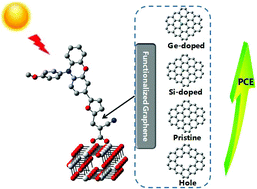Theoretical insights into the effect of pristine, doped and hole graphene on the overall performance of dye-sensitized solar cells†
Abstract
Graphene, a promising two-dimensional carbon material, has been extensively employed in dye-sensitized solar cells (DSSCs) with encouraging results. However, how graphene improves the power conversion efficiency is still unclear. In this research, a series of dyes with pristine, doped and hole graphene based on the dye WS5 were designed and systematically investigated by density functional theory (DFT) and time-dependent DFT (TD-DFT), aimed at revealing the effect of these functionalized graphenes on photophysical properties. The results based on the absorption properties reveal that introducing functionalized graphene not only enhances absorption intensity, but also expands the absorption spectrum, which will lead to a better photocurrent response. According to an analysis of the intermolecular interaction between dye and I2, all the designed dyes possess a slow electron recombination rate, except WS5-HoS, and then possibly an increasing VOC. Additionally, Jph increases steadily as the electronegativity of the doped atoms (C, Si and Ge) in graphene increases. The dyes with the insertion of short functionalized graphene exhibit a superior performance in Jph to that of long functionalized graphene. Meanwhile, using graphene to decorate the dye WS5 could adjust energy levels to narrow the energy gap. Dyes with short functionalized graphene exhibit the smallest HOMO–LUMO gaps, followed by long functionalized graphene and the dye WS5. With the enhancement in the electronegativity of doped atoms (C, Si and Ge) in graphene, the energy gap decreases steadily. Inserting functionalized graphene facilitates electron transfer properties due to lower aromaticities, especially for dyes with short functionalized graphene. Taken all together, the introduction of short functionalized graphene in a dye is a valid approach to increase overall efficiency, especially for graphene doped with atoms of larger electronegativity, so the photophysical properties of DSSCs could be boosted in the future.



 Please wait while we load your content...
Please wait while we load your content...